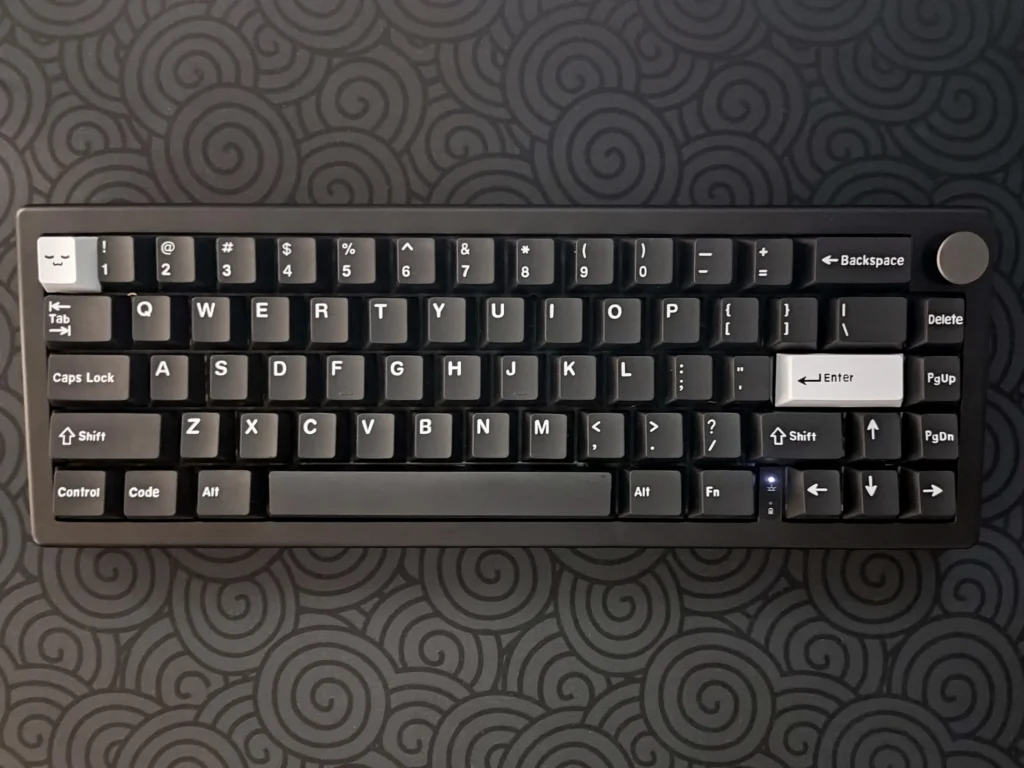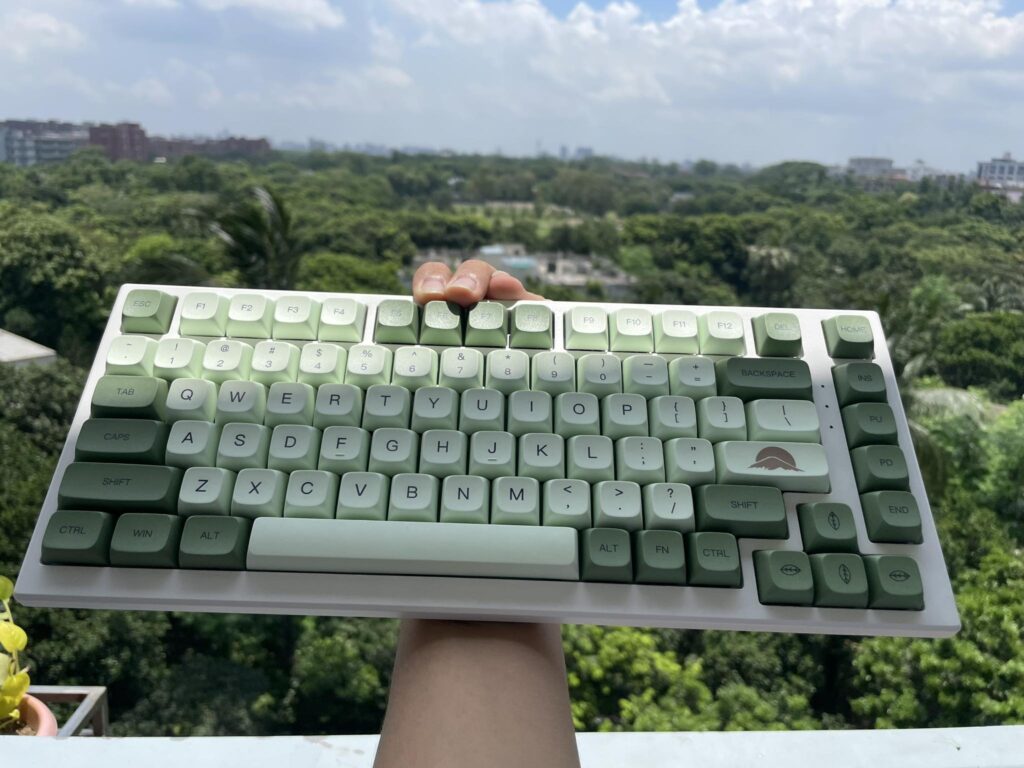In June, I switched keyboards for the first time in five years. This time, I went for a 75% keyboard.
Keyboards and mice are crucial peripherals for any computer user. The ever-progressing computer-dependent world forces users to use computers for long hours each day. Hence, any change to the peripherals, be it small or big, gets noticed over time and affects productivity.
This article will discuss my feelings about my move, and help you decide whether you should as well.

What is a 75% Keyboard?
Let us think of a full-sized keyboard, shall we? A full-sized keyboard has 104 keys. It has the alphabet keys, the spacebar, and all that stuff on the very left. That is the most important, and arguably, the most-used part of the board.
Moving slightly to the right, we have the arrow key cluster. Just above the arrow keys, we have the home, end, and the page keys. These are primarily used for navigating documents while typing.
To the very right, we have a number-pad, commonly referred to as the numpad. This is mostly used for accounting, statistics and other number-centred tasks.
There is an additional row overlooking all of the aforementioned stuff: the F-row or the function row. The function row has the F1-F12 keys. It also has the Scroll Lock, the Pause, and the Print Screen keys.

Now, let us talk about what we can find in a 75% keyboard.
The first and most obvious difference would be the complete absence of a numpad. Then there is the small form factor.
There are the usual alphabet keys to the left alongside the spacebar, shift key and all that stuff. To the right, there are the arrow keys and a vertical arrangement of the home-key cluster.
The F-row oversees the whole board as always, but this time, there is an additional key or two to the right. These are typically the Del and the Ins keys. Here, these keys replace the Print Screen, Pause and Scroll Lock keys.
Mind you, the Ins key might be missing if your board has a knob. Larger extensions, such as a display, can cause the Del key to be absent as well.
Now that you have a basic idea of the 75% layout, let us speak about my experience adjusting with the new layout.

The Absent Numpad
As a game developer, content writer and a programmer, I can safely admit that I do not find much use for the numpad. So it was not a big hindrance to me.
Despite that, the numpad comes in handy in a number of applications. For example, Blender’s default keybinds utilize the numpad for changing views. To combat this problem, I have changed them to the keys in the Home cluster. I can safely attest that it has worked out perfectly for me.
However, I do not represent the vast majority of computer users on planet earth. There are folk associated with accounting, spreadsheet and other number-based professions. The numpad is indispensable for them.
You might happen to be one of them, and still desire a small form factor. In those scenarios, you can look at the 1800 keyboard layout. You can also try getting a separate numpad and using it to your left.
That way, you will be able to use the numpad while still being able to enjoy the amenities provided by a smaller keyboard.

The Vertical Home Cluster
As a power user, I use the Home cluster to a great extent while typing. So, a vertical Home cluster was a significant change. Especially as I had only used a regular three to three Home cluster before.
Now, I was initially adjusted to the Home key and the End key being arranged just above and below one another. The same goes for the Page keys.
However, my new keyboard has the Page keys at the middle of the vertical cluster. That means, my Home and End keys are at either end of the same.
This gave me significant amounts of headaches on my first day with my new keyboard. As you might expect, I constantly kept hitting the wrong keys. However, it took me only a day to get adjusted.
After a couple of months, the vertical Home cluster feels great. Especially in conjunction to the separate Del and the Ins keys. That brings us to our next point of discussion.

The Separate Del and Ins Keys
When typing, the Del key sees significant amounts of usage in my hands. Deleting texts is more efficient when you can properly use this key.
However, I rarely find any use for the Ins key. It is mostly used when working in terminals in certain operating systems. My usage of the Ins key is further limited by the fact that Arch Linux has a different and more convenient shortcut for copy-pasting in terminal.
As a result to combat the absence of the Print Screen key, I use Fn + Ins to click screenshots on Linux.
When it comes to the Del key, I honestly prefer the new positioning over the older one. It is located just above the Backspace key. This makes it really easy to access.

75% vs 65%
When I first purchased the board a few months back, I had to choose between the Monsgeek MG75W and more expensive keycaps, and the GMK67 and cheaper Cherry profile keycaps. I went with the former, as I figured I would need the F-row.
But soon, I realized, I was wrong. Yes, I need the F-row for a bunch of tasks. But I do not find use of it frequently enough to require physical buttons.
Most 65% keyboards, including the GMK67, make the function keys accessible with the Fn button and the number keys. I believe it would not have been too bad.

Keycap Availability
The 75% layout requires some non-standard keycaps. The first would be the smaller right shift. Then there are the keys to the right of the spacebar. They use keycaps of the same size as the alphabet keys.
Thus, it is normal to be paranoid when purchasing keycaps for such a keyboard. But I can safely say, most keycap sets these days offer such non-standard keycaps. Despite that, it is safer to check before buying than to be sorry after having made the wrong purchase.

The Additional Desk Space
The desk space is something that I never thought I would appreciate. But I do! I suddenly have less hiccups while moving my mouse.
I can eat on my desk and not have to block my sound bar by stacking the keyboard against it. It is even easier to carry it around.
Moreover, I can just move the keyboard over my printer when I am not using my board. That includes attending classes, doing assignments for school and everything else. Using anything but a keyboard on your desk is as easy as it can get. These are the perks of having a wireless keyboard with a small form-factor.
However, the most fun is being able to use the keyboard on my lap while typing as I have a wireless board. That is simply an unprecedented luxury not everyone can enjoy.

A Less Hollow Sound
A 75% keyboard is obviously smaller than a full-sized one, and even TKLs. What does that mean? That means there is less space for the sound to reverberate inside the casing. That allows for a less hollow sound coming from the keyboard.
As a result, it is easier to get that thock, clack, or whatever you want from the board. The sound feels more fulfilling. This is a very good reason as to why 75% keyboards are so popular today.
Looks Cleaner?
It is true that looks boil down to personal preference in the end. But in my opinion, the 75% layout simply looks cleaner than a full-sized board. There are just lesser keys and it looks cleaner to the eyes.
It is not just me. In fact, many keyboard enthusiasts think the same way. Personally, I love it when the bezels are medium-sized and the Home and Arrow clusters are separated.
Not to mention, this complements the minimalist desk setups really well. In those setups, where less clutter is the key, a 75% board is an absolutely brilliant addition.

Cheaper Prices
The 75% keyboards have 80-84 keys in general. That means that you have to pay less for switches in comparison to the full-sized keyboards.
Moreover, the barebones sets tend to cost less. This is the result of both the larger demand and the amount of materials being lower.

Some Choices in the 75% Keyboard Space
Conclusion
The 75% keyboard is a layout which takes only a day or two to get adjusted with coming from a full-sized board. It has almost all the keys you would find in a TKL. It simply has a more compact layout.
All in all, the 75% keyboard layout has similar functionality compared to a TKL. But it has a smaller form factor. As such, if you like how it looks, you can look at a 75% as your next keyboard.